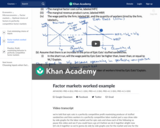
In this video, learn how to apply the analysis of factor markets to a sample problem.
- Subject:
- Economics
- Social Science
- Material Type:
- Lesson
- Provider:
- Khan Academy
- Provider Set:
- Khan Academy
- Author:
- Sal Khan
- Date Added:
- 07/27/2021

In this video, learn how to apply the analysis of factor markets to a sample problem.
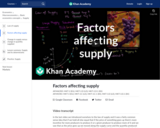
Price changes the quantity supplied, but what might cause supply to increase even if price hasn't changed? In this video, we explore the determinants of supply: those factors that cause an entire supply curve to shift. Created by Sal Khan.
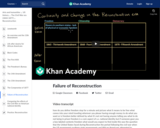
During Reconstruction, three new amendments to the Constitution redefined freedom, citizenship, and democracy in the United States. But how much really changed? In this video, Kim examines continuity and change over time in the lives of African Americans in the South before and after Reconstruction.
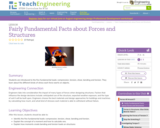
Students are introduced to the five fundamental loads: compression, tension, shear, bending and torsion. They learn about the different kinds of stress each force exerts on objects.

Difference between Historical Cost and Fair Value Accounting. Created by Sal Khan.
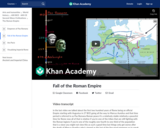
The Roman Empire became less stable over the course of the Third to Fifth centuries CE. Historians point to internal divisions as well as repeated invasions from tribes such as the Huns and the Visigoths as reasons why the Empire fell. The fall of the Western Roman Empire occurred in 476 CE.

Module 2: Students will explore persuasive writing about foods and restaurants. They will also start on their independent opinion writing- to persuade readers to try a favorite (ethnic) food/ restaurant. Please note that this particular Roadmap is a self-directed, project-based extension to a curriculum arc focused on the notion of food as central to our culture.
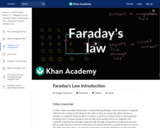
How a current can be induced in a loop of wire by a change in magnetic flux.
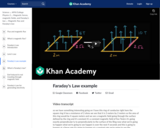
Example calculating induced current based on change in flux.

How Faraday's Law is used to generate electricity in turbines.

This activity focuses on the different types of land use found in rural landscapes.
GeoInquiries are designed to be fast and easy-to-use instructional resources that incorporate advanced web mapping technology. Each 15-minute activity in a collection is intended to be presented by the instructor from a single computer/projector classroom arrangement. No installation, fees, or logins are necessary to use these materials and software.
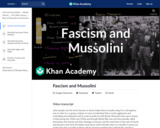
The first fascist regime was established by Benito Mussolini in Italy in 1925. The word fascism comes from "fasci ," an Italian term for "bundle of sticks" that was a symbol for strength in unity. Fascists believe in one-party, totalitarian control of a nation and its economy. Fascist regimes value nationalism and militarization and frequently build nationalist fervor around a concept of shared racial or ethnic superiority. Mussolini's Fascist regime of the 1920s inspired Adolf Hitler's regime in Germany. Created by Sal Khan.
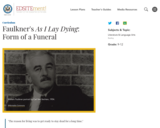
William Faulkner's self-proclaimed masterpiece, As I Lay Dying, originally published in 1930, is a fascinating exploration of the many voices found in a Southern family and community. The following curriculum unit examines the novel's use of multiple voices in its narrative.
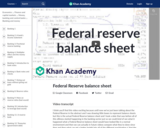
Analysis of the federal reserve balance sheet as of Feb 2007. Created by Sal Khan.
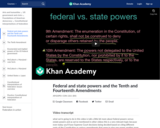
Federal and state powers and the 10th and 14th amendments.

A list of powers in the United States along with a graphic organizer to show whether these powers belong with the nation, state, or are shared. Easy reference for the student to use throughout the semester to identify who holds which powers. Can be used to assess understanding of power distribution also.
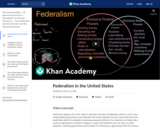
Federalism in the United States. Exclusive and concurrent federal and state powers.
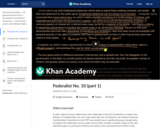
Part 2 of a close reading of excerpts of Federalist No. 10 where Madison makes the case that the type of large republic constructed by the Constitution of 1787 is favorable to any other form.

As students read have them note the ways in which Hamilton says the judiciary's power will be limited.

This curriculum unit explores some of the most important arguments of those opposing or supporting the ratification of the U.S. Constitution.